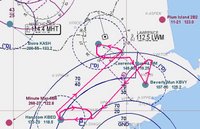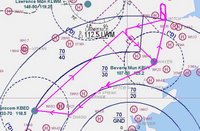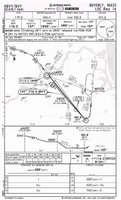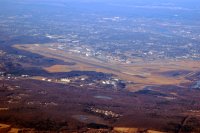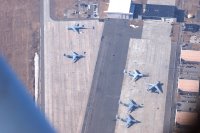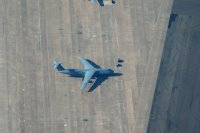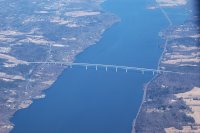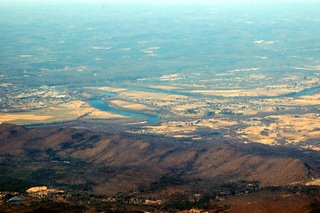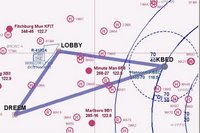
Last week it was flying in sunny, warm southern California. Today it was back to Hanscom field and balmy 18 degrees. Winds on the ground were 290 degrees at 18 knots gusting to 28. This was supposed to be a dress rehearsal for my 2nd stage check which is scheduled for next Sunday. I wasn't too thrilled about shooting holding patterns in this much turbulence and wind which was supposed to be from the north at close to 50 knots at 3,000 feet.
I was freezing by the time I completed preflighting the aircraft and called for pre-heat. Just as the pre-heating was complete, the office called and wanted to know if I could move to a different 172SP since the next renter needed short fuel on that one and they'd like me to burn off an hour or two of fuel. Being the wonderful person I am, I retied down the first aircraft and now froze through a second pre-flight.
My instructor Josh came out and apparently we were going to be the only ones up at the 7:30 hop; everyone else was canceling because of the wind. I figured if I could fly these patterns with this much wind, it would build my confidence for the actual stage check. So off we went.
This was a day of no waiting. We were #1 for takeoff from runway 29 and I was off the ground and climbing about 15 seconds down the runway due to he wind. The climb out was like a rollercoaster as I put on my foggles and leveled off at 3,000 feet. Josh gave me a holding clearance to hold northwest of DREEM intersection. I entered the ID into the Garmin GPS and proceeded direct to DREEM bouncing along rather nicely. I decided to climb and find some smoother air. The ride was much better at 3,500 so I leveled off, slowing to 90 knows about 4 minutes from the fix. The entry was a teardrop which required about 45 degrees of wind correction to stay on the protected side of the hold. With a groundspeed of about 55 knots (no kidding) I extended the outbound leg to 2 minutes and still wound up with a 45 second inbound leg. A second orbit worked out nicely and we were established in a good holding pattern , wind and all.
"Cessna 21693, proceed direct to LOBBY and hold as published. Expect further clearance at 1320," was the next thing I heard from the CFII's mouth. So LOBBY went into the computer and I turned the plane to the north. According to the enroute chart strapped to my leg, LOBBY is a non-standard hold meaning you make left turns instead of right. The entry was direct and no problem so we had a stable hold set up by the second orbit. Just as I was feeling pretty please with myself, Josh reached over to cover up the attitude indicator with a suction cup.
"OK. You've had an attitude indicator failure. turn to 240 and descend at 500 feet per minute to 3,000 feet." Great.....The turbulence started picking up again as we left 3,500 for 3,000. I leveled the plane off at 3,000 using the altimeter as primary reference with the vertical speed indicator supporting. So far so good.
"I've got the controls," Josh said. "Let's try some partial panel abnormal attitudes with at the attitude indicator covered up. Close your eyes and let me know if your starting to get sick. I sometimes get overly aggressive with these maneuvers." I closed my eyes and started to feel vertigo and he started to wheel the plane up and down, jinking to the left and right. The idea is to get your head spinning as if you lost your orientation in the clouds and had to recover the plane from an abnormal attitude. Just about the time I was starting to get queasy, he let go of the controls and said, "Recover!"
I opened my eyes and looked first at the airspeed indicator which was in the yellow arc and climbing. I immediately reduced throttle to idle. With no attitude indicator I couldn't see if we were level but a quick look at the HSI and turn coordinator showed a rapid turn to the left....A diving spiral! I rolled wings level so as to not overload the wings in my pullout and then pitched up the nose using the altimeter and VSI to establish I was back in straight and level flight. Once the airspeed settled down, I got some throttle back in and got the plane back under control. The whole thing was over in 5-10 seconds. We did a secondd one and Josh was satisfied that I could pass the stage check next week.
We headed back to Hanscom and we were #1 for landing on a short final. The wind shear was awesome! On final approach we lost 15 knots of airspeed about 200 feet above the runway so I added power and ate up more runway than usual. It all worked out. I guess I'm as ready for stagecheck #2 as I'll ever be....we'll see next Sunday.
 Got a late start tonight...but oh, what a night! Clear skies, beautiful sunset and finally.....spring weather. Deprted Bedford after 6 p.m. on runway 5 and climbed directly to Lawrence VOR to shoot the VOR approach into Lawrence. Good intercept, good procedure turn to reverse course and good VOR alignment. But just busted the MDA before the MAP. Executed a missed approach and headed north to buy some time and then headed to the VOR approach into Beverly. Same thing again, just busted the MDA. Lesson learned? Start level off about 50 feet above the MDA and stablize the altitude. Other than that, it was pretty good.
Got a late start tonight...but oh, what a night! Clear skies, beautiful sunset and finally.....spring weather. Deprted Bedford after 6 p.m. on runway 5 and climbed directly to Lawrence VOR to shoot the VOR approach into Lawrence. Good intercept, good procedure turn to reverse course and good VOR alignment. But just busted the MDA before the MAP. Executed a missed approach and headed north to buy some time and then headed to the VOR approach into Beverly. Same thing again, just busted the MDA. Lesson learned? Start level off about 50 feet above the MDA and stablize the altitude. Other than that, it was pretty good.